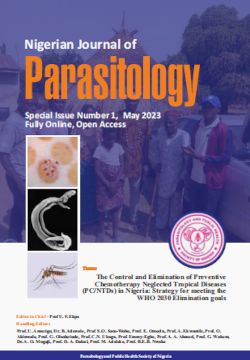The burden of anaemia in Plasmodium falciparum parasitized and non-parasitized children, Minna, north-central Nigeria
http://dx.doi.org/10.4314/njpar.v40i2.7
Keywords:
hemoglobin, hematocrit, AnaemiaAbstract
Plasmodium falciparum infection may cause severe anaemia, particularly in children. There are several kinds of anaemia, produced by a variety of underlying causes. This study however, was conducted for a period of 3 months between February and May, 2018, to assess the frequency and types of anaemia in malarial infection. A total of 301 children below 17 years were recruited from the community and selected healthcare facilities. Thick and thin films of the blood samples were prepared for parasite identification and a complete blood count was conducted to determine the presence of anaemia. Multinomial logistic regression was used to predict relationships between anaemia and P.falciparum. Children with anaemia as a result of low levels of hemoglobin and hematocrit were observed as 65% and 61% respectively. Meanwhile, in parasitized subjects, prevalent rates of anaemia decreases with age and the overall prevalence was recorded as 49%(150) and 47%(142) in children with low levels of hemoglobin and hematocrit respectively. It was also observed that P. falciparum parasite was not a significant factor in the anaemia transmission (p>0.05). Similarly, anaemia prevalence decreases as the severity intensified (from severe, to moderate and mild), with most prevalence observed in mild anaemia 31%(96). The attributable risk of anaemia by malaria in this study was observed in low hemoglobin anaemia as 7.12% which was lower than what was observed in low hematocrit anaemia 8.11%. This study provides a significant relationship between anaemia sub-types and malaria infection and proves anaemia to be a major public health problem in this community as over 60% of the study population had anaemia.
References
Chaudhry, H. S. and Kasarla, M. R. 2017. Anemia, microcytic hypochromic. Allama Iqbal Medical College, Jinnah Hospital.
WHO. 2001. Iron deficiency anemia, assessment, prevention, and control: a guide for program managers, WHO, Geneva, Switzerland.
Brabin, B. J., Hakimi, M. and Pelletier, D. 2001. Irondeciency anemia: reexamining the nature and magnitude of the public health problem. Journal of Nutrition, 604S-615S.
Stoltzfus, R. J. 2001. Defining iron-deficiency anemia in public health terms: A time for reflection. Journal of Nutrition, 131:2, pp. 565S-567S.
van Hensbroek, M. B., Jonker, F. and Bates, I. 2011. Severe acquired anaemia in Africa: New concepts. British Journal of Haematology, 154(6): 690-695.
Menendez, C., Fleming, A. F. and Alonso, P. L. 2000. Malaria-related anaemia. Parasitology Today, 16(11):469-476. doi: 10.1016/S0169-4758(00)01774-9.
van Eijk, A. M., Ayisi, J. G. and ter Kuile, F. O. 2002. Malaria and human immunodeficiency virus infection as risk factors for anemia in infants in Kisumu, Western Kenya. The American Journal of Tropical Medicine and
Hygiene, 67(1): 44-53.
Ong’echa, J. M., Keller, C. C. and Were, T. 2006. Parasitemia, anemia, and malarial anemia in infants and young children in a rural holoendemic Plasmodium falciparum transmission area. American Journal of Tropical Medicine and Hygiene, 4(3): 376-385.
Koukounari, A., Estambale, B. B. A. and Kiambo Njagi, J. 2008. Relationships between anaemia and parasitic infections in Kenyan school children: A Bayesian hierarchical modelling approach. International Journal
for Parasitology, 38(14): 1663-1671.
Achidi, E.A., Apinjoh, T.O.,Anchang-Kimbi, J. K., Mugri, R. N., Ngwai, A. N. and Yafi, C. N. 2012. Severe and uncomplicated falciparum malaria in children from three regions and three ethnic groups in Cameroon:
Prospective study. Malaria Journal, 11: 215.
Price, R. N., Simpson, J. A. and Nosten, F.2001. Factors contributing to anemia after uncomplicated falciparum malaria. American Journal of Tropical Medicine and Hygiene, 65(5): 614-622.
Buffet, P.A., Safeukui, I., Milon, G., Mercereau-Puijalon, O. and David, P.H. 2009. Retention of erythrocytes in the spleen: A double-edged process in human malaria. Current Opinion in Hematology, 16(3): 157-164.
Phillips, R. E., Looareesuwan, S. and Warrell, D. A. 1986. The importance of anaemia in cerebral and uncomplicated falciparum malaria: role of
complications, dyserythropoiesis and iron sequestration. The Quarterly Journal of Medicine, 1986,58(227): 305-323.
Phillips, R. E. and Pasvol, G. 1992. Anaemia of Plasmodium falciparum malaria. Baillieres Clinical Haematology, 5(2): 315-30.
Idro, R., Aloyo, J., Mayende, L., Bitarakwate, E., John, C. C. and Kivumbi, G. W. 2006. Severe malaria in children in areas with low, moderate and high
transmission intensity in Uganda. Tropical Medicine and International Health, 11: 115-124.
World Health Organization. 2010. Guidelines for the treatment of malaria (2nd Ed.). Geneva: World Health Organization. 2010, p. ix. ISBN 9789241547925.
Trape, J. F. 1985. Rapid evaluation of malaria parasite density and standardization of thick smear examination for epidemiological investigations. Transactions of the Royal Society of Tropical Medicine and Hygiene, 79(2): 181-184.
Omalu, I. C. J., Mgbemena, C., Mgbemena, A., Citation Yamman, H. U., Omalu, I. C. J., Abubakar, A., Abolarinwa, S. O. and Eke S. S. Ayanwale, V., Olayemi, I. K., Lateef, A. and Chukwuemeka, V. I. 2012. Prevalence of congenital malaria in Minna, north-central Nigeria. Journal of Tropical Medicine, Article ID 274142, 5 pages.
Sumbele, I. U. N., Sama, S. D., Kimbi, H. K. and Taiwe, G. S. 2016. Malaria, moderate to severe anaemia, and malarial anaemia in children at presentation to hospital in the Mount Cameroon area: A cross-sectional study. Anemia, 5725634.
Cheesbrough, M. 2009. District Laboratory Practice in Tropical Countries. Part 1-2. Edinburg Building, UK: Cambridge University Press.
Mishra, S, and Mohanty, S. 2002. Problems in management of severe malaria. The Internet Journal of Tropical Medicine, 1:1.
Mockenhaupt, F. P., Bienzle, U., May, J., Falusi, A. G., Ademowo, O. G., Olumese, P.E. and Meyer, C, G. 1999. Plasmodium falciparum Infection: Influence on hemoglobin levels in Ö-thalassemia and microcytosis.
The Journal of Infectious Diseases, 180:3, 925-928.
Downloads
Published
How to Cite
Issue
Section
License
Copyright (c) 2023 Nigerian Journal of Parasitology

This work is licensed under a Creative Commons Attribution-NonCommercial-NoDerivatives 4.0 International License.





